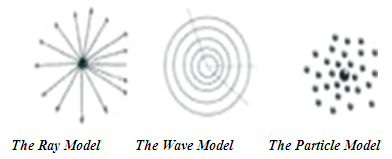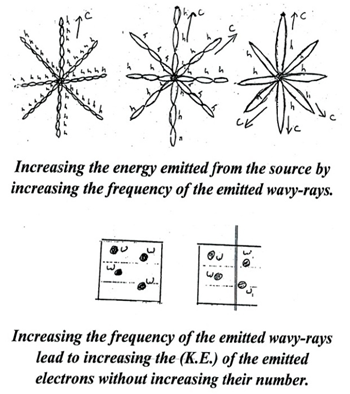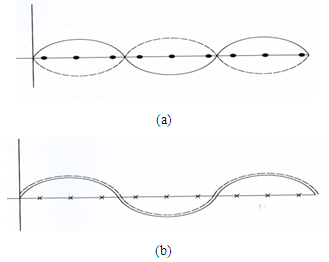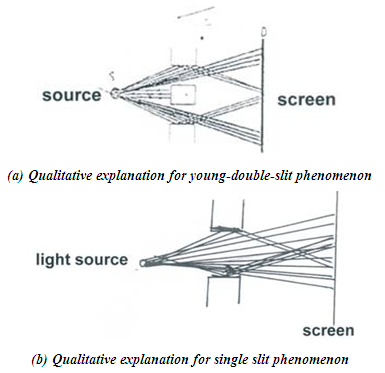-
Paper Information
- Paper Submission
-
Journal Information
- About This Journal
- Editorial Board
- Current Issue
- Archive
- Author Guidelines
- Contact Us
International Journal of Optics and Applications
p-ISSN: 2168-5053 e-ISSN: 2168-5061
2017; 7(1): 1-6
doi:10.5923/j.optics.20170701.01

The Wavy Ray Model: A New Light Model
Mohamed Ashraf Farouk
Department of Physics, Ain Shams University, Cairo, Egypt
Correspondence to: Mohamed Ashraf Farouk, Department of Physics, Ain Shams University, Cairo, Egypt.
| Email: |  |
Copyright © 2017 Scientific & Academic Publishing. All Rights Reserved.
This work is licensed under the Creative Commons Attribution International License (CC BY).
http://creativecommons.org/licenses/by/4.0/

Despite Planck was recognized as the originator of quantum physics, he struggled for it throughout his life until his death. He never accepted his hν as Einstein’s photon. He believed that the origin of, hν, had not been discovered yet. In addition, the photon concept caused Einstein regret throughout his life. He wrote; I spent all my life trying to understand what a photon is, and haven't understand it by now, so the quanta are a hopeless mess. Is it possible or can we resolve such problem, which the eminent physicists consider it as a hopeless mess. In this article, I'm trying to obtain the Planck quantization of radiation energy E = n h ν, by a picture appealing to the imagination, I'm trying to introduce a new light mode called the wavy ray model.
Keywords: Wave particle ray photon duality
Cite this paper: Mohamed Ashraf Farouk, The Wavy Ray Model: A New Light Model, International Journal of Optics and Applications, Vol. 7 No. 1, 2017, pp. 1-6. doi: 10.5923/j.optics.20170701.01.
Article Outline
1. Introduction
- When Einstein faced the photoelectric results, he realized that the wave theory alone fails to account such results. In addition, he realized that the particle theory also fails because the energy of the emitted electrons is function of frequency and the frequency is a wave property. So what he supposed to do? What he supposed to do? Einstein did not think of constructing a new light model and restart interpretation over again. The particle and the wave models have captivated him, may be some one advice him to apply Hegel dialectic or Hegel triadic
 in Philosophy to solve this scientific problem. Therefore, he borrowed the localization from the particle theory and he borrowed the frequency from the wave theory and affirmed them together in a single theoretical entity named the "Photon".The question is "How the energy of localized packet depends on non-localized property as the frequency, no one could answer that question even Einstein himself.In my own view, the word "photon" acquired its existence between us due to long usage and not due its actual existence. The logical positivism philosophers realized that, there are many of non-sense words which people get accustomed to use it. The disaster is the thinking as long as there is a word in physics it must has a pear (analogous) in nature. The physicists exchange the word photon as they talk, so it must be digestible information. No, for me this word cannot constitute a picture at all because its falseness lies in its interior structure (Contrary descriptive structure).
in Philosophy to solve this scientific problem. Therefore, he borrowed the localization from the particle theory and he borrowed the frequency from the wave theory and affirmed them together in a single theoretical entity named the "Photon".The question is "How the energy of localized packet depends on non-localized property as the frequency, no one could answer that question even Einstein himself.In my own view, the word "photon" acquired its existence between us due to long usage and not due its actual existence. The logical positivism philosophers realized that, there are many of non-sense words which people get accustomed to use it. The disaster is the thinking as long as there is a word in physics it must has a pear (analogous) in nature. The physicists exchange the word photon as they talk, so it must be digestible information. No, for me this word cannot constitute a picture at all because its falseness lies in its interior structure (Contrary descriptive structure).2. New Light Model
- I have a wish, to find out (to approach) the real form by which light do propagate. I collect the experimental results and I tried to give them a better understanding. I found myself more attached to construct a new light model (a new possibility for the transfer of energy) rather than to continue with the false wave-particle duality view. I reconsider the ray model which is long disregarded and I tried to unify all the three light models into one single picture (the wavy ray model). I hope to solve the whole light phenomena together. That is the difference between my way and the physicist way in which they think in each phenomenon alone, separated from the other phenomena as Heisenberg said. So that one should be always have the whole picture in his mind, before one tries to fix a theory in mathematical or other language.
2.1. The Wavy Ray Model
- The suggested wavy ray model is based on the following postulates:(1) The monochromatic light point source emits energy in the form of wavyrays emerging in all directions (see figure (1)).(2) Each wavy ray consists of identical sections (wavy ray parts) of equal length, l. Each wavy ray section contains energy b= 6.6 x 10-27 erg. The b’s dimensional formula is ML2T-2.(3) The length of each separate wavy ray section, l, is different for different monochromatic sources.(4) The polychromatic source emits wavy rays which having different wavy ray section lengths (i.e mixture of different wavy rays)(5) The emerging wavy rays distributed discontinuously (separately) over a surface of a sphere.(6) The single wavy ray has a front area, W, moving in straight path with the speed of light, C, in vacuum.(7) The frequency of each wavy ray, ν, is the number of full sections that pass a given point in space per unit time ν=C/l. It should be noted that; it is naturally to speak about the frequency of the wavy ray while it is meaningless to speak about the frequency of a point particle or photon.(8) A wavy ray is an idealization, it meant to represent an infinitely narrow beams of energy. It can be assumed that; each single wavy ray interacts only with a single electron, i.e. the front area of the wavy ray is smaller than the electron dimensions.Since, the mathematical equation is the simplest form to express the relation between the physical quantities and shows the physical meaning, one can write the energy radiated from the monochromatic source as:
 | (1) |
 | (2) |
 | Figure 1a. Particle, ray and wave models |
 | Figure 1b. Wavy ray model |
3. Interpretation of Photoelectric Effect
- Equation (1) explains the quantization of radiation. Equation (2) can be used to explain the photo electric effect as follows:The energy incident on unit area per unit time can be increased by two ways:a- By increasing N, the no of emitted wavy rays from the point source, which leads only to increase the number of emitted electrons, without increasing their kinetic energy.b- By increasing, ν, the frequency of each wavy ray, or the energy carried by each wavy ray per unit time which leads to an increase in the kinetic energy of the emitted electrons without increasing their numbers. This interprets the dilemma of the photo electric effect.
 | Figure 2a |
 | Figure 2b |
3.1. Interpretation of Planck Constant
- For the first time in the history of physics, in 1900, in his interpretation for the black body radiation, Planck introduces the idea of quantization of radiation. He introduced a new physical constant, h, known as Planck’s constant h = 6.6 x 10-34 j.s. It should be noted that; the unit, j.s, of the Plank’s constant is a meaningless unit. Also its dimensional formula (energy multiplied by time) has not any physical significance.I agree with Planck for discarding the idea that an oscillator could gain or lose energy continuously but by a discrete amount. The difference between me and Planck lies in that, Planck said that the discrete amounts is an integral multiple of (hν, 2hν, 3hν, ...) I say this is true quantitivily. However; I only suggest to write the same discrete amount determined by Planck but by different way such that: 1νbT, 2νbT, 3νbT, where b = 6.6 x 10-34 J is the energy contained in each wavy ray section, its unit is joule, it is an energy and it has a physical meaning, ν is the frequency and T is the illumination time.I would like to clarify that the secrete behind the successes of both the wave and the particle models so far is that because both models contains elements of the wavy ray model as follows:1- The wave model has a wavelength as the wavy ray section length and both the wave model and the wavy ray model has the same frequency.2- The particle model its energy is quantized and it produces spots (or dots) on the screen as the wavy ray model.
3.2. Comment on the Interpretation of Compton Effect
- There is a great mistake which is considering Compton effect as a strong evidence for the particle nature of light. The physicists interpreted the reduction in the energy of the high energetic X-ray radiation or gamma ray radiation when they scattered by free electrons as a collision between the photon and the free electrons. They ignore the fact that the proposed factious photon could not produce such collision for the following reasons:1- According to the law of the relativistic addition of two velocities C+V=C, C-V=C i.e the proposed photon has a fixed speed, its speed cannot exceed C or less than C. However, the inelastic collision essentially depends on the variations of the velocities of the collided masses before and after collision. 2- The proposed photon is a mass less entity, it has not a rest mass, what collision is that? Collision between what!!Why the physicists are doing that? That is because they are sure there is no physical way based on wave mechanics could interpret the observed increased in the wavelength. As I think if one of the two pictures is failed, the physicists attribute the phenomena automatically to the second picture, because they could not confess that the two picture which they don’t know any about them are failed to account for these phenomena.
4. Young Double Slit Experiment
- My comment is divided into two parts; 1- showing that the double slit pattern is not an interference wave pattern. I want to worn against (or to notify of a fault), which is the title of this phenomenon. The physicists often called it wrongly (the interference experiment). I would like to say that they have confused the phenomenon itself with the interpretation model, Calling the resultant pattern of Young experiment as interference pattern this will cause us to confiscate any new different future interpretation for this experiment. So I prefer to call it double slit pattern. Let us look a bit more closely at this experiment: according to the classical theory of electricity and magnetism, the pattern that formed when a coherent beam of light passes through the double slit apparatus arises from the superposion of two electromagnetic waves one diffracted from each slit. The detector in the Young experiment measures the light intensity. This quantity is proportional to the squared magnitude of the resultant electromagnetic field at the detector:
 | (3) |
 | Figure 3 |
 | Figure 4 |
5. Single Slit Phenomena
- It should be noted that; calling the single slit pattern as a diffraction pattern this confiscating any new future different interpretation for that pattern. Physicists interpreted the single – slit pattern by combining Huygens secondary sources with the principle of superposition.The physicists interpret the single – slit experiment by modifying their view for the single continuous wave front, they replace it by many separate sources (Huygens factious sources).To explain the observed pattern physicists postulate unjustifiably the following:(1) Each point on the wave front is considered as a source of a secondary wave.(2) Postulate that these secondary wavelets produce an effect only on their forward direction.(3) The secondary waves interfere according to the principle of super position.The only physicists dispute such wave interpretation Hugh David Young, in his "Optics and modern physics" he wrote;(1) The procedure prescribed by Huygens principle may not seem to make any physical sense at all, since it is clear that there are not any sources of radiation in the apertures. In fact this one place we can be certain, there are no sources. (2) However, the assumption of uniform distribution of sources across the apparatus leads to the observed diffraction pattern".Concerning the first part of his statement."I'm in complete agreement with Prof. Hugh that there no meaning for assuming the existence of not existing sources.(1) The second part of Prof. Hugh statement I'm in complete disagreement with him. Because, these secondary waves interfere according to the principle of superposition; which means breaching the law of conservation of energy at each point as I clarified in the double – slit pattern.(2) In my own view since the target of physics is to acquire accurate and reliable knowledge, i.e. to arrive a valid interpretation for natural phenomena. Then, we should immediately search for a new different explanation for both "the double-slit, and the single-slit" experiments using a new different model.
|
6. The Results
- 1. We obtained the quantization of light energy (the old E= nh) by picture appealing to the imagination. The picture I am offering is one that is open to discussion and experimental verification.2. I clarified that neither the photoelectric effect nor the Compton Effect could be considered as a direct demonstration for the particle nature of light.3. I clarified that neither the double – s lit pattern is an wave interference pattern nor the single slit pattern is a wave diffraction pattern.
7. Conclusions
- 1. The mental image I am offering for the way light spreads is the result of my attempt to offer a one single model that explains the whole different light phenomena. I believe this model is experimentally verifiable.2. Light has not wave nature3. Light has not particle nature4. Light has not dual wave-particle nature5. The actual nature of light is still remained undiscovered yet.
ACKNOWLEDGEMENTS
- I would like to express the deepest appreciation to Professor El Sayed Yehia El Zayat, for fruitful discussion and scientific comments. In addition, a thank you to professor Salah Arfa, who encourage me to complete this dissertation.
 Abstract
Abstract Reference
Reference Full-Text PDF
Full-Text PDF Full-text HTML
Full-text HTML